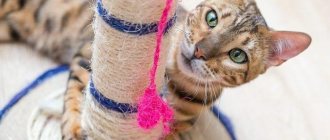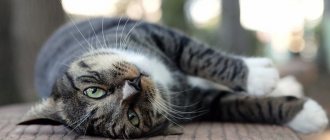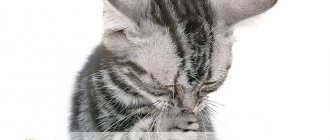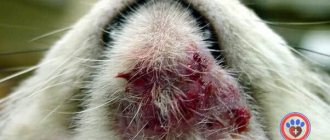Etiology
Poisoning is a condition when the body is affected by a toxic substance that has entered from the outside or formed inside. Usually the process is lightning fast or acute, but sometimes it becomes chronic and protracted. Many factors can trigger the response.
Causes:
- bad food, dirty water;
- inhalation of fumes from chemicals;
- eating poisonous plants;
- insect, spider, snake bites;
- violations in the dosage of medications.
Nutritional factor is the most common cause. It happens that a pet swallows or inhales herbicides, fertilizers, household chemicals, paints or varnishes. Sometimes the owner overdos the dose of the drug.
Vodka against worms
If intestinal parasites are detected, you can give your pet vodka. The therapeutic effect consists of the rapid absorption of alcohol into the walls of the gastrointestinal tract, resulting in poisoning and death of the worms. It is recommended to give half a teaspoon twice a day. Continue taking for 3 days. After this, in order to reduce the harmful effects of alcohol, feed the cat milk or fermented milk drinks for several days.
Clinical picture
Every owner should know how to identify poisoning in a cat. Symptoms depend on the amount and type of toxin, the route of entry, and the initial state of health of the pet. A condition that increases the chance of poisoning is pain, weakness.
Manifestations:
- loss of appetite, thirst - the first sign;
- apathy, lethargy, inactivity;
- nausea, vomiting, diarrhea are a typical symptom;
- pallor, altered reaction of the pupils to light;
- unsteadiness when walking, difficulty breathing.
The cat begins to react strangely to what is happening around him and get scared. Characterized by weakness and muscle pain. Gradually, the animal retreats into corners and pays less attention to stimuli. In severe cases, convulsions, seizures, coma and death occur.
Help with frostbite
In winter, cases of frostbite in furry pets are common. Most often, the tail, limbs, ears or nose are affected. The main signs of frostbite are pale skin in the area of the lesions and the appearance of dense swelling. In severe cases, the skin of the mustachioed tabby becomes covered with blisters or swelling.
Treatment with vodka. In case of significant frostbite, “fire water” comes to the aid of a loving owner. Saving a cat from exposure to low temperatures must occur in strict order:
- First, the affected areas should be washed with soap and water. The liquid should not be too cold or hot. You need to start with a temperature of +18-20°C, gradually bringing it to 40°C.
- Then the animal needs to be rubbed with vodka, gently massaging the frostbitten areas.
- After restoring blood flow to the cat, give the cat another rub.
It is important to remember that if it is not possible to bring a frostbitten pet indoors, you should place it under clothing and warm it with your own heat.
Rubbing with snow is contraindicated for animals.
Also watch the video: Is it worth treating dogs and cats with vodka:
Doctor's actions
The veterinarian examines the patient, collects anamnesis and conducts the necessary tests to determine what the root cause is and how to treat the cat in case of poisoning. Veterinarians work according to a standard plan. Activity:
- administration of saline solutions, gastric lavage;
- injections of B vitamins;
- adsorbents, antiemetics;
- glycosides, antioxidants, diuretics.
A therapeutic diet will help maintain and improve your health. The veterinarian will advise what to feed the cat after poisoning. A pet should not go long without food. It's better to start with warm meat broth. If everything is normal, then it is allowed to give boiled meat with boiled rice porridge, gradually returning the animal’s usual diet.
Incorrect treatment of atopic dermatitis. 5 main mistakes
Atopic dermatitis is a chronic inflammatory skin disease that causes itchy red patches, rashes, peeling and dryness. This disease is diagnosed in 30% of children and 10% of adults. However, atopic dermatitis is often not given due attention, and incorrect treatment of this disease can slow down the onset of remission and worsen the overall level of health. Dermatologist Anna Trushina talks about the 5 most common mistakes in treatment tactics.
Mistake #1. Excessive diagnostics aimed at identifying “non-skin” causes.
The reasons for the development of atopic dermatitis lie in genetically determined features:
1. From the skin - associated with a violation of the barrier function.
2. From the immune system. In response to the penetration of irritants and allergens through a broken skin barrier, inflammation forms.
Therefore, it is not advisable to look for the cause in helminths, disturbances of intestinal microflora, intoxication, etc. The entire range of examinations prescribed in this regard only because of atopic dermatitis is not justified. Efforts aimed at finding the “root cause” outside the skin are better directed towards competent treatment of the skin itself.
Mistake #2. Search for the causative allergen.
Atopic dermatitis is not an allergic disease in nature. However, allergic reactions can be combined with atopic dermatitis as a concomitant disease. This happens in approximately 20-30% of patients.
Therefore, atopic dermatitis itself is not a reason to undergo expensive panels for specific allergens, and the test should only be taken if a specific allergic reaction is suspected in some patients.
Mistake #3. Following an unreasonable diet.
Often atopic dermatitis becomes the reason for prescribing a strict “hypoallergenic” diet. Children's diet becomes monotonous and boring. However, such dietary restrictions are not scientifically justified and do not bring the desired result, even if there is an allergy at the same time.
In addition to the lack of effect, a strict diet can harm the body. It leads to deficiencies of important nutrients, minerals and vitamins, which can negatively affect the overall health of the child. Therefore, children with atopic dermatitis need to eat a varied and balanced diet. Only those foods whose role has been clearly proven to aggravate the pathological process are excluded from the diet. Similar rules apply to the mother’s diet if the baby is breastfed.
Mistake #4. Irrational skin care.
The basis of the treatment of atopic dermatitis is the restoration of the skin barrier function and the elimination of inflammation. Therefore, products are prescribed that help HYDRATE and soften the skin and retain moisture inside it, and thereby improve the protective properties of the skin. The complex also uses measures that reduce the likelihood of developing an inflammatory process, i.e. skin contact with potential aggressors from the external environment is limited.
To achieve the goals listed above, careful and careful care of the skin of an atopic child using EMOLENTS is required. These are special products, lotions, creams, balms, which, when applied to the skin, soften and moisturize it, help fill the intercellular spaces in the skin, restoring its barrier properties.
It is important to understand that using simple baby creams 1-2 times a day may not be enough. Proper care requires the application of special emollients in sufficient quantities. They are distributed in a thick (!) layer on both problem and visually unchanged areas of the skin. At the same time, the frequency of application directly depends on the condition of the skin. It is necessary to use emollients so many times during the day that the skin remains smooth, soft and without flaking to the touch all day.
Mistake #5. Refusal of “hormones”.
With atopic dermatitis, an inflammatory process occurs inside the skin (the word “dermatitis” itself, literally translated into Russian, means inflammation of the skin). That is why during an exacerbation, anti-inflammatory external agents are used to stop the inflammation. These drugs include external glucocorticosteroids. However, many parents refuse these “hormones” due to steroidophobia (fear of using steroids).
Topical (i.e., used externally: lotions, emulsions, ointments, creams) corticosteroids have been used in the treatment of atopic dermatitis for decades. During this time, they have demonstrated high efficiency and a high safety profile.
If parents do not use corticosteroids in cases where there are indications for this, or do it irrationally (prescribed independently without taking into account the degree and form of skin inflammation, independently cancel the hormone before the required time without the supervision of a doctor), then this can lead to deterioration of the skin condition , the formation of foci of chronic inflammation and other local complications.
Conclusion
Atopic dermatitis is a fairly well-studied disease with established mechanisms of development. Regular skin care, timely relief of inflammation and the elimination of unnecessary aggressive manipulations and diagnostic procedures will help cope with this disease as effectively as possible.
How does distemper manifest in cats?
The main symptom of plague is a body temperature of 40-41 degrees
The main symptoms of panleukopenia:
- temperature 40-41 o C;
- vomiting and diarrhea;
- weakness;
- dry skin;
- sunken eyes;
- enlarged lymph nodes in the intestine, which can be felt by palpation.
From the onset of the disease, the pet refuses to eat and drink. He loses interest in everything and almost doesn't get up. The vomit is watery or greenish. Gradually it becomes mucous, with traces of blood.
Feces have a liquid consistency and a foul odor. They also contain blood impurities. Due to severe spasms, the cat cannot drink, although she is tormented by severe thirst. When affected by the heart virus, a dry cough occurs. The cat breathes through its mouth, the mucous membranes become bluish.
Sometimes after these symptoms appear, the cat gets better within a few days. It happens that an animal dies even at the first signs of illness.
Treatment of plague
The panleukopenia virus is very persistent, and there is no effective single cure for it. Therefore, an integrated approach to the treatment of the disease is required. To do this, they use both etiotropic drugs to destroy the pathogen and drugs to relieve symptoms.
The antiviral drug Fosprenil is used more often. It is administered intramuscularly. For a cat weighing up to 1 kg, a single injection is 0.2 ml, 1-5 kg - 0.5 ml. Treatment should last at least 14 days. At first, 4 injections are given per day, gradually reducing to 1.
Enterostat 20 mg/kg is used once a day. The course lasts 7 days.
Symptomatic therapy for panleukopenia is aimed at reducing the signs of the disease.
To rid your pet's body of toxins, you need to give him diuretics. Decoctions of horsetail, bearberry, and lingonberry leaves are suitable. The cat must be given antibiotics throughout the entire treatment period, since the distemper virus causes secondary bacterial infection.
Vitamins and iron supplements (Ferrodextran, Ursoferran) must be included. To normalize metabolic processes, Catozal is prescribed for 7 days. To relieve spasm and pain, the cat is given Dibazol or No-shpa.
Distemper: how to deal with this cat disease
Cats are susceptible to many diseases.
One of the most dangerous is plague (panleukopenia). This is a fatal disease that is important to recognize in time. If measures are not taken in time, 90% of cases end in death for the pet.
Therefore, you should study the main signs of distemper in order to protect your cat from death. This viral disease is not dangerous for humans.
Risk group
Cats under 6 years of age are at the least risk of developing panleukopenia. Over the years, the animal's body becomes depleted. Its protective functions become weaker. And then plague infection becomes practically unhindered.
Cats aged 6-8 years are considered a high risk group. But the greatest danger of infection is in kittens and young animals under 1 year of age. If a pregnant cat gets sick, she miscarries, the cubs become nonviable or mummify.
Methods and ways of infecting cats with distemper
The virus that causes distemper enters the external environment along with the urine, feces, and saliva of sick cats, as well as those that have recovered from this disease. You can become infected with panleukopenia through hygiene items that come into contact with your cat.
Pets become infected after drinking from a container from which a sick animal drank, while walking on the street where a carrier of the virus was walking. It is not necessary to have close contact. Even if the animal has already been ill, the distemper virus can survive in the house for 6-12 months. After recovery, the cat is still considered a carrier of the virus.
It is possible that feline plague can be transmitted in utero or that it can be carried by blood-sucking insects. Humans can also carry the virus. But he himself does not suffer from the plague. The infection can be brought on by shoes or dirt particles on clothing. Unfortunately, the causative agent of the disease cannot be eliminated by disinfecting the premises.
Cats heal people.
Of course, treatment with cats is largely based on the energy exchange between the animal and its owner. According to Eastern medicine, all human diseases arise due to energy imbalance in the body. The process itself consists of absorbing bad energy and processing it. By and large, if you look at it in detail, cats do this out of necessity - that’s just the way cats are designed.
It is bad for a cat when there is not enough negative energy, but it is also bad for her when there is too much of this energy. That is why the furry doctor clearly knows when he needs to stop the “recharging” process and run away from the person. Communication with a cat is also a scientifically proven effective method of treatment and recovery, which, as a rule, goes unnoticed, but is very effective. A cat is a pet that is given to a person to help and should be in every home.
Experts note the special healing energy of these animals, depending on the breed of the cat, but in general the mechanism of such treatment is not important, because there is only one conclusion: after the cat lies next to your sore spot, the pain subsides significantly, and you are on the mend. And if you doubt whether cats cure any diseases, try checking it out.
If the cat likes you, the animal will naturally be drawn to you - and accordingly, in this way you will allow the cat to treat you. In this case, the cat will not only give you its energy, but will also increase its bioenergetic abilities.
This is all the more important because the conditions of the surrounding world are perceived by the human subconscious as a threat; people experience a feeling of fear and uncertainty about the future. Domestic cats absorb these fears, appeal to warm feelings and thereby satisfy the owner's need for security and trust.
Kosh
Source
Benefits and harms
Alcohol has a detrimental effect on the entire body if you give your cat too much of the drink. First of all, the liver and stomach suffer. Vodka has a diuretic effect on the kidneys, therefore, in addition to toxins, beneficial vitamins and substances are removed from the animal’s body. Alcoholic drinks destroy the walls of blood vessels, disrupt the functioning of the heart, increase arrhythmia and increase blood pressure. Alcohol also has a negative effect on the nervous system and dulls vision.
However, despite all the listed disadvantages of vodka, there are also positive qualities. It has antiseptic and antibacterial properties. Various herbal tinctures, elixirs, balms and rubs are prepared using alcohol. They are used externally internally as a cure for many diseases.










